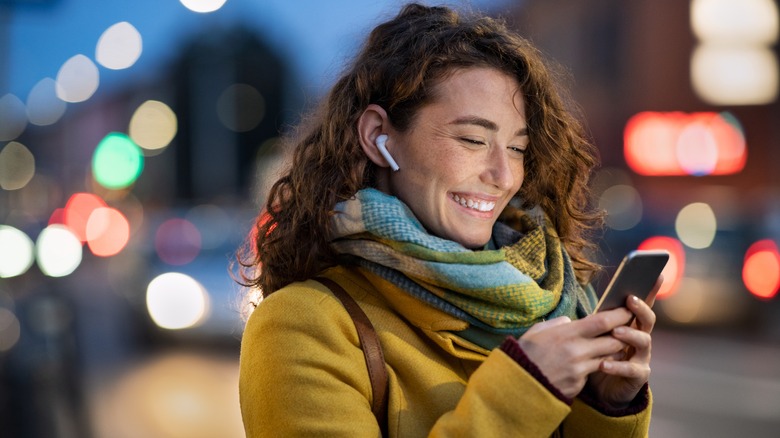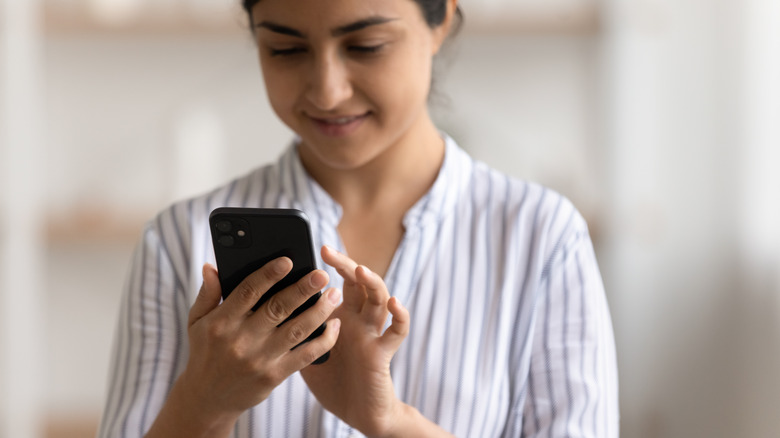When To Use A Yellow Heart Emoji To Make Sure You're Sending The Right Message
When it comes to text messages, tone can easily get lost in translation. Something as simple as "OK" can have multiple implications — frustration, support, or reassurance. Fortunately, emojis are here to clarify — after all, a picture is worth a thousand words. Or at least a couple dozen.
At the turn of the millennium, Japanese artist Shigetaka Kurita designed the first-ever emoji, per Wired. It wasn't until 2011 that emojis were accessible through iOS, and, four years after that, different skin tone options were incorporated into the emoji catalog. "When Unicode first started to encode emoji, there were only about 700 concepts in your keyboard," Jennifer Daniel, chair of the Emoji Subcommittee at the Unicode Consortium, explains to NPR. Now, that number is nearing 4,000.
According to Wired, a staggering 92% of people use emojis, with the most popular icons being the crying-laughing face and the tears of sadness, per Brandwatch. The red heart is a close runner-up. Over the years, it's evolved to include other colors like green, purple, and blue, each with a different interpretation. "The heart is my number-one favorite emoji, because among the various emoji, (its meaning) is very positive," says none other than Shigetaka Kurita in an interview with CNN. If you choose to use the yellow heart emoji, know that it has an entirely different implication than the red — or even the pink — hearts.
The yellow heart indicates friend zone status
Whereas the red heart emoji is the universal symbol of love — and those two pink hearts have overtly flirty undertones — the yellow heart typically means friendship or family connection (via Cosmopolitan). According to Urban Dictionary, sending a yellow heart is equivalent to friend-zoning. If you're looking to imply a lack of romantic interest — but still wish to pursue a platonic relationship — this emoji should do the trick. As assistant editor Naydeline Mejia tells Women's Health, "It's great to send to friends, acquaintances, and mutuals who you want to be friends with IRL." Alternatively, use the yellow heart in messages with close family members.
TikToker @iloevbrentfaiyaz share their emoji interpretation, agreeing that the yellow heart indicates that you just want to be friends. Historically, yellow roses are a symbol of amicable love. "Receiving a yellow rose from someone means that they wish joy for you, and view you as a joy in their lives," celebrity psychic Inbaal Honigman explains to Well + Good. "It's such a happy color, which reminds us of summer fields, long, sunny days, and sandy beaches. That's the energy of yellow." However, if a romantic hopeful isn't getting the hint from yellow hearts alone, it's time to reject them kindly with your words.
How to let someone down with your words
Using the yellow heart emoji isn't a surefire way to the friend zone — ultimately, it's always best to communicate directly, even at the risk of awkwardness. Yes, that means avoiding the infamous ghosting method. "The two keys are tact and honesty when letting someone down," dating coach Erika Ettin informs Elite Daily, noting, "While someone might be disappointed that you don't want to go out again, he or she can't really be angry at you for feeling, or not feeling, how you do." Whether over text or in person, stick to direct phrasing. "Be respectful, and explain yourself clearly," suggests Dr. Suzanne Wallach, PsyD, LMFT, a licensed marriage and family therapist, in a conversation with Insider.
Atlanta-based professional counselor Bianca Walker explains two very different forms of rejection to Women's Health. In her words, "Rejecting someone in a mean way says, 'there's something wrong with you,' which is very different from, 'I know what I want and I don't think we're compatible.'" The bottom line? Rather than continue a relationship that lacks chemistry, prioritize your well-being. Though sending a yellow heart is a good first step, plan to have a more honest conversation somewhere down the road.


